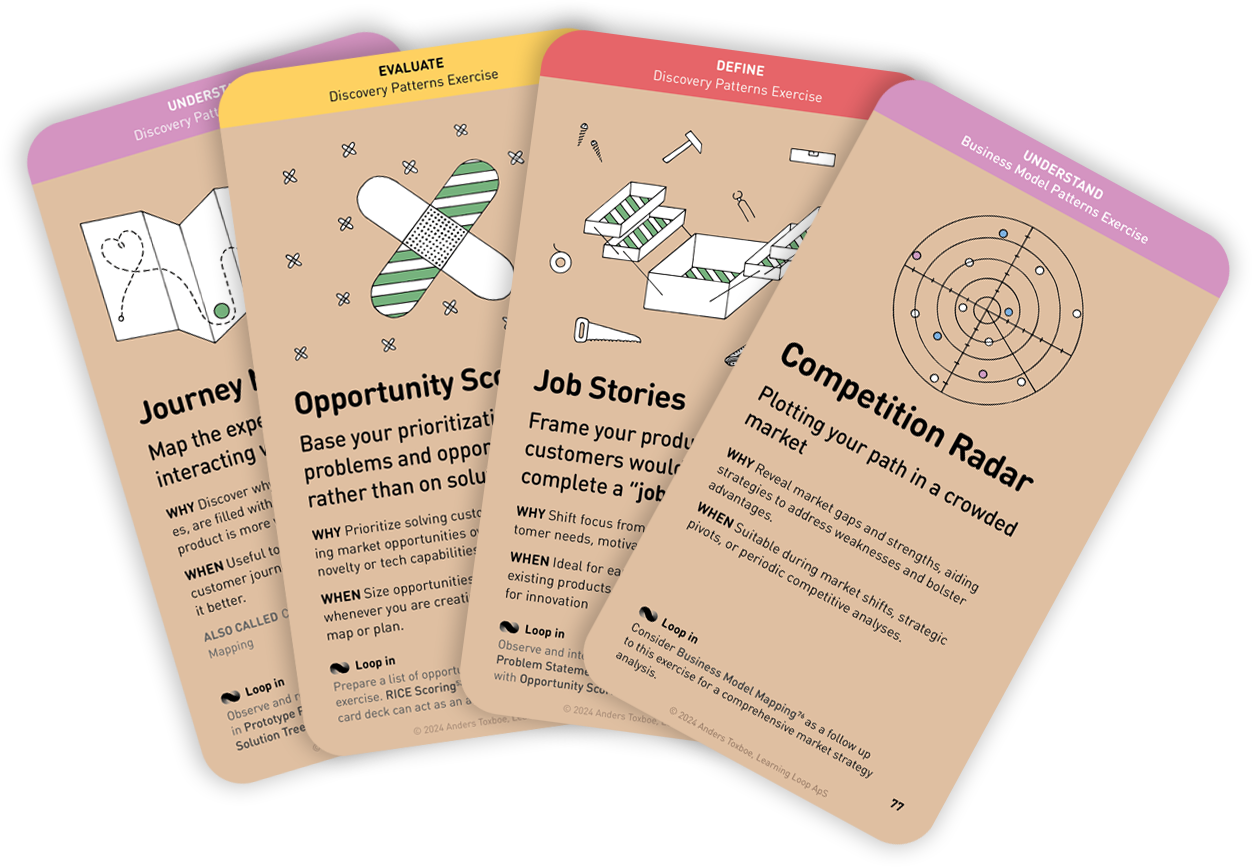Workshop Exercises: Define
Persuasive Driver Selection
Select the main persuasive drivers of your project

Why: Establishing guidelines on how psychology is used to guide the user along will address inconsistencies in user experiences as more behavioral principles are being applied.
When: Ideally performed as part of narrowing down your problem definition.
Let participants identify and prioritize the primary behavioral drivers that will underpin the strategy of their project. By outlining these psychological drivers at the project’s inception, teams can align their efforts around shared, human-centric principles, ensuring coherent and effective strategic development.
The goal of the exercise is to trim the list of 80 persuasive patterns into a predetermined list of 5 persuasive patterns that will be used going forward in the design process.
This exercise represents a departure from classical Design Thinking, where the first steps are to understand and define the problem of the user. Instead, this exercise represents a view where the designer designs with purpose and intent, wishing to not only solve the user problem, but also doing it while leaving the user in a particular emotional state and by using defined means to the end. This approach can be particularly useful as behavioral designers start applying a multitude of persuasive patterns to the point where there is no red thread in how the user is being motivated or pushed around.
By deciding on a few main persuasive drivers, designers can align on means in which the user is sought to be motivated and ensure consistency in the experience. This will help align on shared vision and establish guidelines to address product experiences inconsistencies introduced by employing too many psychological drivers.
Instructions for running this play
- Introduce the exercise
Brief participants on the need to agree on a subset of persuasive drivers that will steer users forward toward their goals. - Evaluate the user
Define what characterizes the user and what the archetypical target user is known to be motivated by. - Define the situation the user is in
Identify and describe the context in which the user will act. - Define the behavioral goal
Identify what behavioral goal you’re trying to let users achieve and what characterizes it. Is it long-term (reciprocity) or short-term (competition)? - Define the business goal
What do you want to achieve as a business? A conversion? Adaption? Loyalty? Attitude change? - Define the user problem
Finally, define the problem that if solved in the identified context, will have the biggest impact on the business and help the user forward. Consider using Focus Mapping exercise for this. - List drivers
Have participants list potential persuasive patterns relevant to the project. Encourage groups to consider diverse aspects such as user needs, motivations, behaviors, and emotions. - Prioritize
Have each group prioritize their listed drivers based on their perceived impact and relevance to the project. Encourage groups to debate and reach a consensus on the top psychological drivers that should underpin the project’s strategy. - Present
Each group presents their prioritized list of persuasive drivers to the other participants. Facilitate a discussion to align on the common psychological drivers that will guide the project strategy, considering the inputs from all groups. - Agree on the top 5 drivers across groups
Combine similar persuasive drivers identified during the discussion and decide through group discussion, which are the top 5 psychological drivers that are to be the foundational principles for the project’s strategic development. - Debrief and discussion
Summarize the identified and agreed-upon psychological drivers and discuss the implications of these drivers on the project’s strategy and development.
Once you have the drivers defined, it is much easier to carry out Intervention Design while keeping a red thread to the rest of your product.
A collection of workshop exercises that will help you ditch dull meetings and facilitate with confidence. It will help you master the design process and have more productive time with your team. The card deck will be ready for purchase in the end of 2026 and is now undergoing rigorous testing.
Reserve your deck!- Cugelman, B., & Stibe, A. (2016). Persuasive backfiring: When behavior change interventions trigger unintended negative outcomes. In H. Oinas-Kukkonen et al. (Eds.), Persuasive technology. PERSUASIVE 2016. Lecture notes in computer science (Vol. 9638, pp. 65-77). Springer.
- Christensen, A.-K. K., Gram-Hansen, S. B., & Damyanov, D. N. (2020). Behaviour Design Sprint: Let’s play a game. In Proceedings of the Department of Communication and Psychology. Aalborg University.

